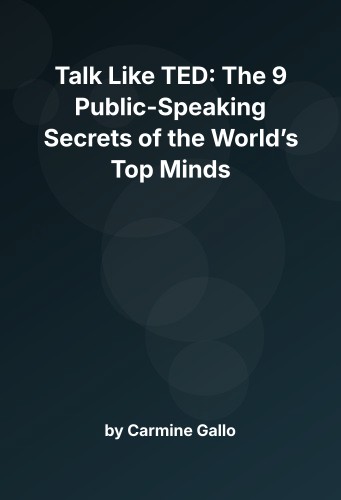Talk Like TED: The 9 Public-Speaking Secrets of the World’s Top Minds
By Carmine Gallo
Introduction
In Talk Like TED, communications coach Carmine Gallo explores what makes TED Talks some of the most compelling presentations on the planet. By analyzing hundreds of TED Talks and interviewing leading speakers and neuroscientists, Gallo distills nine practical techniques that can help anyone become a more effective communicator — whether you’re presenting on stage, in the boardroom, or at a community event.
The core message: great speakers don’t just inform — they inspire.
Part 1: Emotional — Touch Hearts Before Minds
1. Unleash the Master Within
Passion is contagious. The most compelling TED speakers are deeply passionate about their topics. Passion ignites energy and emotional connection, which in turn makes ideas resonate.
Gallo advises:
- Speak about what you truly care about
- Find a topic that aligns with your core purpose
- Reframe dry content to highlight its emotional stakes
Audiences respond to authenticity. If you’re not excited, they won’t be either.
2. Master the Art of Storytelling
Stories stick. Research shows that stories activate more areas of the brain than data alone. They create empathy and anchor abstract ideas in relatable experiences.
Types of stories TED speakers use:
- Personal stories
- Stories about other people (e.g. students, customers)
- Historical or business case studies
Structure:
- Conflict → Struggle → Resolution
- Include vivid detail, emotional highs/lows, and a clear point
Storytelling isn’t decoration — it’s structure.
3. Have a Conversation
The best speakers don’t perform — they connect. They use conversational tone, natural pacing, and inclusive language.
Key techniques:
- Use contractions (you’ll, it’s)
- Make eye contact
- Speak with warmth and calmness
- Pause for emphasis
- Avoid jargon
TED speakers sound like they’re talking with the audience, not at them.
Part 2: Novel — Deliver Something Unexpected
4. Teach Something New
Novelty stimulates attention. TED speakers often present new insights, surprising facts, or fresh perspectives on familiar topics.
You can create novelty by:
- Sharing counterintuitive findings
- Debunking myths
- Revealing little-known history
- Presenting analogies that reframe understanding
Audiences crave insight — give them something they’ve never thought of before.
5. Deliver Jaw-Dropping Moments
A “jaw-dropping moment” is a dramatic, emotional, or memorable element that surprises the audience and captures attention.
Examples:
- Props or physical demonstrations
- Emotional confessions
- Eye-opening statistics
- Bold claims backed by evidence
These moments trigger dopamine, making ideas easier to recall. Just one can anchor your entire message.
Part 3: Memorable — Present Ideas for Impact
6. Lighten Up
Humor humanizes. The best TED speakers use light-hearted moments to connect, relieve tension, and make content more engaging.
Tips for appropriate humor:
- Self-deprecation
- Anecdotes from daily life
- Observational humor
- Light teasing (used carefully)
You don’t have to be a comedian — just let your natural humor emerge.
7. Stick to the 18-Minute Rule
TED Talks are capped at 18 minutes — and for good reason. This time limit:
- Encourages discipline and clarity
- Matches the average attention span
- Allows multiple talks in one sitting
Even outside TED, aim for concise, tightly edited presentations. Focus on one major idea. Less is more.
8. Paint a Mental Picture
Visual communication boosts understanding and memory. Great speakers use metaphors, vivid language, and effective slides.
Recommendations:
- Use high-quality images, not bullet points
- Limit text per slide
- Use analogies to connect the abstract to the familiar
- Describe scenes with sensory detail
The brain remembers pictures better than prose.
9. Stay in Your Lane (Be Authentic)
The most powerful presentations come from being yourself. Embrace your quirks, show vulnerability, and speak from lived experience.
Authenticity builds trust. TED’s format rewards diversity of personality and voice — and so does the real world.
Beyond the Stage: Applying TED Techniques
Gallo emphasizes that these tools are not just for TED Talks. They can be used in:
- Business pitches
- Job interviews
- Educational lectures
- Sales presentations
The principles are universal: emotion, novelty, clarity, brevity, and authenticity.
Neuroscience Insights
Gallo weaves in brain science to support his strategies:
- Emotion enhances recall (amygdala activation)
- Novelty triggers dopamine (attention and learning)
- Stories activate multiple brain regions (mirror neurons)
Effective presentations are both cognitively engaging and emotionally resonant.
Key Takeaways
- Speak with passion — it fuels connection.
- Tell stories — they are remembered far more than facts.
- Sound conversational — not performative.
- Share new insights — people love to learn.
- Create a wow moment — it anchors your message.
- Use humor and vivid visuals — to engage and retain attention.
- Keep it short — simplicity beats complexity.
- Be yourself — authenticity is your superpower.
Talk Like TED is an actionable, inspiring guide to modern communication. Whether you’re pitching a startup or presenting in a classroom, Gallo equips you to captivate, educate, and move your audience — just like the world’s top TED speakers.

